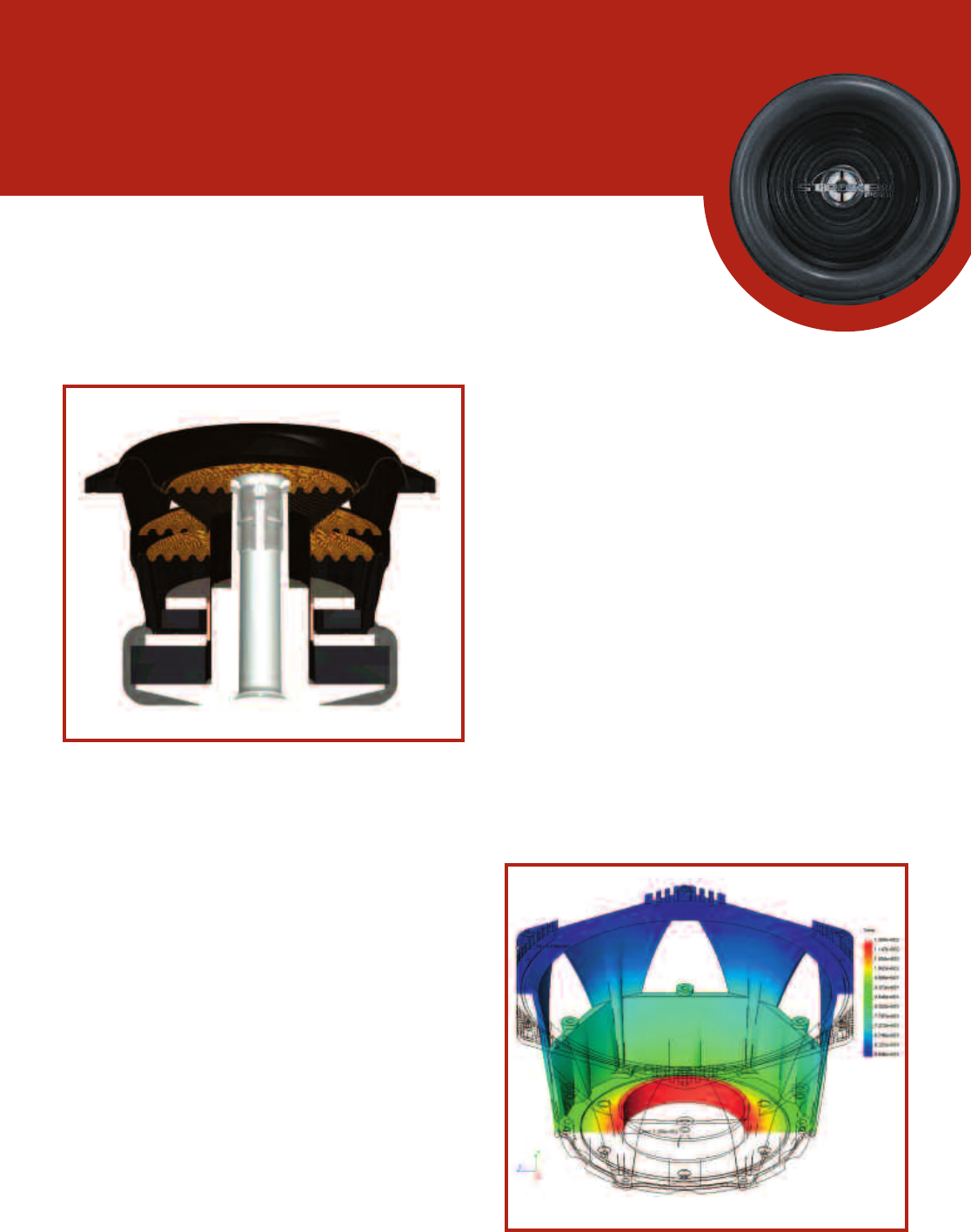
shelf’s 10 1/4” diameter except for the six 1/2”-
diameter mounting posts that it suspends from.
This gives substantial venting area for the airflow
generated by the lower spider motion to move air
past the exposed voice coil and top plate. For the
air caught between the two spiders, there are an
additional six 1/4” x 2” vents. At the back side of the
motor you have a series of six 3/32” diameter
peripheral vents that move air from between the
pole piece and the voice coil out the back of the T-
yoke. Lastly, an aluminum-sleeved 1 3/4” diameter
pole vent powered by the large, moving clear plas-
tic dustcap supports the third spider at the top of
the woofer. Because of this, the sleeve extends to
about double the height of the pole, and thus acts
as another heatsink.
The real heart is the MMAG motor structure.
Since the voice coil is shorter than the combined
length of the two gaps, it appears similar to a con-
ventional underhung voice coil motor. In the con-
ventional motor, as the short coil rides out of a sin-
gle large gap in either dir
ection, the total number of
voice coil turns in the gap decreases and so does
the total Bl, or total horsepower, of the motor.
However with the Str
oker Pro dual-gap motor, the
situation is more like hav-
ing two gaps working in
unison. As the number of
turns starts decreasing in
one gap, the number of
turns in the other gap
increases so that the num-
ber of voice coil turns of
wire in the gap stays con-
stant. The cool part is that
it operates in a way that
the two gaps are always
working in conjunction
with each other such that
the number of turns does
not begin decreasing until
the voice coil starts to
leave just one gap. (See
sidebar on pg. 73 for more
information on dual-gap
technology.)
Other features for the Stroker Pro motor include
a forged and CNC-milled single piece T-yoke that
includes an extended pole piece with a pole vent.
This vent gives access to a patented adjustable spi-
der bias system for the top or third spider. All the
original Stroker woofers
had this adjustment sys-
tem; however, it was set
at the factory for maxi-
mum linearity. Stroker
owners found that tweak-
ing this setting enabled
the woofers to play even
louder. Biasing a spider
toward the front side and
causing the voice coil to
be deliberately off-cen-
tered toward the front of
the gap area creates high-
er amounts of even-
ordered distortion (2nd
and 4th harmonics to be
exact). Besides the warm
tones caused by the
biased spider
, the
increased even-order distortion also increases the
bass due to a psycho-acoustic phenomenon called
the missing fundamental (which produces percep-
tion of low bass from notes an octave higher). So, if
you want to go from very clean linear bass to an
altered warm bass sound quality, Stroker Pro
woofers come with a tool that allows the user to do
that.
One of the key features to good subwoofer per-
formance is a solidly stiff cone, and the cone in the
Stroker is about as stiff as it gets. Built from layered
carbon graphite and thick paper, the cone is further
reinforced by the large 7 1/2”-diameter clear poly-
carbonate dustcap. Long excursion in a subwoofer
requires the suspension to move long distances.
One solution is incorporating a wide surround that
allows the cone to move further. However, this
decreases the cone area, which in turn requires the
cone to move further! Cerwin-Vega’s patent-pend-
ing solution is SdMaxx (Sd is an engineering abbre-
viation for the area of a cone). Rather than being
low and wide, the polyether foam surround is more
of an ellipsoid shape, tall and narrower. The result is
the same excursion ability, but a greater cone diam-
eter and area. The other part of the SdMaxx system
is an attachment design that allows the entire cone
Figure 1
Figur
e 2








